Best email sorter tools
- Jotform Gmail Agent: Best email sorter for Gmail automation
- Superhuman: Best email sorter for professionals
- Shortwave: Best email sorter for advanced AI automation
- SaneBox: Best email sorter for maximum control
- Clean Email: Best email sorter for daily use
- Spark: Best email sorter that is also a regular email app
- Edison: Best email sorter for regular people
- Missive: Best email sorter for teams
- Mailstrom: Best email sorter for an already overflowing inbox
- NewMail: Best email sorter you don’t have to set up yourself
- Drag: Best email sorter for Gmail-loving teams
Email overload is real. The average professional has received more than 100 emails per day for the last few years, many of which are not “business critical.” In other words, most people are dealing with an overflowing inbox on a daily basis.
While email isn’t going anywhere, the tools to handle it are getting better. Specialized email sorters can save hours by filtering out unnecessary messages and, most crucially, flagging the really important ones. These tools are great for task prioritization.
The best email sorters also have other features that make keeping on top of your inbox as simple as can be. Some can use AI to draft replies. Some can automatically unsubscribe you from newsletters. And some can filter out entire senders. Whether you work in sales, handle email marketing, or are just a regular person with a lot of emails, sorting tools can really help out.
In this list, we look at the best email sorting software available to help you deal with your overflowing inbox. We consider AI email sorters, rules-based email sorters, email apps that have integrated email sorting, and separate tools that can clear out any overflowing inbox. Some of the apps, like Jotform’s Gmail Agent, combine smart automation with trustworthy human control — a winning combination.
The top email sorter tools to organize your inbox: A quick comparison
Here’s an overview of our favorite email sorting tools in 2025.
Jotform Gmail Agents |  Superhuman |  Shortwave |  SaneBox |  Clean Email |  Spark |  Edison |  Missive |  Mailstrom |  NewMail |  Drag | |
|---|---|---|---|---|---|---|---|---|---|---|---|
| Best for | Gmail automation | Professionals | Advanced AI automation | Maximum control | Daily use | Email sorter + full email app | Free option for regular users | Teams | Overflowing inbox cleanup | Set-it-and-forget-it (Gmail only) | Gmail-loving teams |
| Key features | Auto-labels, drafts replies in your tone, surfaces only important emails | Superhuman AI, split inbox, custom AI labels, top-tier keyboard shortcuts | Anthropic’s Claude for sorting and drafting, auto-organization, AI-powered search | Compatibility with nearly any email service, “Power Tools” (SaneLater, SaneBlackHole, etc.), Daily Digest emails | Broad account support, decluttering tools, unsubscribe and block features, weekly roundup | Spark +AI for drafting, summarizing, translating; Smart Folders; new-sender filtering | Desktop and mobile clients, “Focused” vs “Other” inbox, auto categories like Travel, Subscriptions, etc. | Shared inboxes, collaboration, assignable emails, integration with chat/SMS/WhatsApp | Overview of inbox mess, mass archive/delete, expiring emails, sender blocking | AI auto-categorization (Urgent, Important, etc.), natural-language filters, daily briefing, draft replies | Shared Gmail-based inbox, rule-driven automation, task management, analytics |
| Pricing | Free plan; paid tiers add advanced AI features | Starter: $30/user/mo. Business: $40/user/mo. (for full sorting features) | Free plan; paid plans from $18/mo. | Snack: $7/mo. (2 tools) Lunch: $12/mo. (6 tools) Dinner: $36/mo. (all 11 tools) | $9.99/mo. (1 account) $19.99/mo. (≤ 5 accounts) $29.99/mo. (≤ 10 accounts) | Free plan Premium Individual: $59.99/yr. | Free (anonymized data sold unless opted out) | Starter: $18/user/mo. Productive: $30/user/mo. (adds automation) Business: $45/user/mo. (advanced analytics) | Free trial Basic: $9/mo. (1 account) Plus: $14/mo. (≤ 3 accounts) Pro: $29.99/mo. (≤ 20 accounts) | Free plan Solo: $15/mo. Pro: $30/mo. | Free trial Starter: $16/user/mo. (10 rules Plus: $18/user/mo. (unlimited rules) Pro: $24/user/mo. (teams with advanced workflows) |
| G2 rating | 4.7/5 | 4.7/5 | 4.4/5 | 4.9/5 | 4.4/5 | 4.7/5 | 4.7/5 | 4.2/5 | 4.5/5 |
The 11 best email sorters in 2025
1. Jotform Gmail Agent: Best email sorter for Gmail automation
Key features: Jotform Gmail Agent seamlessly drafts replies and auto-labels and surfaces only those emails needing attention.
Jotform Gmail Agent is one of the most powerful email sorters available — and it works directly in your Gmail inbox. Since it uses OAuth, you don’t have to share your password or worry about someone else reading your emails.
Jotform Gmail Agent automatically labels emails as they arrive in your inbox using AI, so it’s fast and flexible. It is especially effective for customer support, sales, and other high-volume communicators as it has the ability to keep only important and urgent messages visible. Have you ever wondered, “What are AI agents?” This kind of helpful workflow is the answer.
In addition to sorting your emails, Jotform Gmail Agent can also automatically draft replies. It trains itself on your email history and any other resources you provide, like FAQs and employee handbooks. This helps it learn to match your company’s tone of voice and answer queries correctly, though it will never send an email without human approval.
Pros:
- Combines smart automation with human oversight
- Learns your unique tone of voice from your email history for on-brand communication
- Adaptive labeling keeps only important emails visible
Con:
- Doesn’t work with other email services
Pricing: Free plan available; advanced AI features in paid tiers
G2 rating: 4.7 out of 5
2. Superhuman: Best email sorter for professionals
Key features: Superhuman’s AI and best-in-class keyboard shortcuts work with Gmail and Outlook.
Designed for busy professionals with overflowing inboxes, Superhuman is a great email app built on top of Gmail and Outlook..
Superhuman uses a split inbox to highlight important emails from your coworkers and VIP clients or about mission-critical tools while hiding messages that don’t require your immediate attention. It also automatically labels emails using AI — and with the Business plan, you can define your own custom labels.
But sorting emails is just one feature of Superhuman. My favorite feature is its keyboard shortcuts. The onboarding tutorial teaches you how to rip through your inbox at maximum speed: replying to, sorting, or archiving emails with quick keyboard taps. For busy professionals who really need to stay on top of email, it’s one of the best tools available.
Pros:
- Keyboard shortcuts
- Powerful and flexible email sorting
- Effective AI email assistant
Cons:
- Expensive
- Best features not available on cheapest plan
Pricing: Starter plan ($30 per user per month); Business plan ($40 per user per month) for best email sorting features
G2 rating: 4.7 out of 5
3. Shortwave: Best email sorter for advanced AI automation
Key features: Shortwave uses Anthropic’s Claude models to sort and respond to emails. It automatically organizes your inbox and offers a powerful AI search.
Shortwave is an AI-first email app. It uses AI to sort emails, search your inbox, and draft replies. You can set it up to sort your emails automatically, or ask the AI agent to organize your inbox based on any criteria you have. For such a powerful tool, it’s incredibly easy to use.
Shortwave’s AI agent can also draft emails for you based on specific prompts. For example, you can ask it to look through your inbox and send your boss a summary of the biggest tasks you have to do or a list of clients you’ve emailed this week.
In addition to automatically organizing your email, Shortwave can also help you create different inbox tabs for things like Google Docs notifications or team communications. Shortwave will then filter emails into the corresponding tabs.
Unlike some other AI email apps, Shortwave has a free plan so you can check it out with no commitment required. It’s more limited than the paid plans — the AI can only work with a handful of emails at once — but it should give you a good idea of what Shortwave is capable of doing.
Pros:
- Advanced AI features are easy to use
- Automatically sorts email
- Turns emails into clear action items
Cons:
- Only works with Gmail
- AI search is limited to 50 email threads on individual plans
Pricing: Free plan available with basic AI features; paid plans from $18 per month with advanced AI features
G2 rating: 4.4 out of 5
4. SaneBox: Best email sorter for maximum control
Key features: SaneBox offers multiple ways to sort and organize your overflowing inbox and works with your regular email app.
SaneBox is a standalone email sorting service that works with Gmail, Outlook, iCloud Mail, and almost every other major email service. It also supports IMAP and Microsoft Exchange accounts. You can use its web app to purge your overflowing inbox, unsubscribe from unwanted newsletters, ban annoying senders, and create rules to sort and organize your incoming mail.
SaneBox offers very flexible pricing. Its basic features are included on every plan, but the platform divides its most powerful features into “Power Tools” with names like SaneLater, SaneBlackHole, and SaneCC. The lowest-tier plan allows you to use any two tools, while the top-tier plan lets you use all 11..
So you don’t miss anything, SaneBox sends a Daily Digest with a summary of all the emails it filtered out. That way, even if it does misfile an email, you can do something about it.
Pros:
- Works with every major email service as well as IMAP
- Lets you use any email app you want
- Offers flexible pricing
Cons:
- Expensive if you want all its features
Pricing: Snack plan ($7 per month) includes two Power Tools; Lunch plan ($12 per month) includes six Power Tools; Dinner plan ($36 per month) includes all 11 Power Tools
G2 rating: 4.9 out of 5
5. Clean Email: Best email sorter for daily use
Key features: Clean Email offers multiple email sorting tools, a modern and easy-to-use interface, and dedicated mobile apps.
Clean Email is an email sorting service that works with Gmail, Outlook, Yahoo, iCloud Mail, AOL, and any IMAP email account. While you can still use any email app you want, you can also reply to emails directly from Clean Email.
Clean Email has lots of different email sorting options. It can sort your emails into folders, block senders, pause or unsubscribe you from email newsletters, block all new senders until you approve them, and more. Depending on how much control you want, you can have Clean Email operate automatically or only when you choose to clean up your inbox.
One cool feature is the weekly roundup — that’s when Clean Email takes multiple newsletters and combines them into a single weekly email so they don’t clutter up your inbox.
Pros:
- Works with most email accounts
- Stands on its own as a real email app
- Helps declutter an already overflowing inbox
Con:
- Expensive for single accounts
Pricing: One account for $9.99 per month, five accounts for $19.99 per month, or 10 accounts for $29.99 per month
G2 rating: 4.4 out of 5
6. Spark: Best email sorter that is also a regular email app
Key features: Spark is a modern and powerful email app with great sorting features. It filters new senders by default, offers dedicated mobile apps, and works with multiple email accounts.
Spark is a fully featured modern email client. It’s really nice to use; and with the control center and keyboard shortcuts, you can fly through your inbox replying to messages, archiving things that you no longer need, and banishing annoying newsletters. Spark +AI can also automatically write emails, summarize threads, and even translate emails. There are also smartphone apps so you can access Spark on the go.
In addition to being a great email app, Spark is also an excellent email sorter app. By default, every new sender is kept out of your inbox until you approve them. You can also block annoying senders if you don’t want to hear from them again. On top of that, Spark can automatically organize your email into Smart Folders that you define. That way, you can group all the emails from one client or every email with an attachment into a dedicated folder.
If you want an email sorter that’s also your regular email app, Spark is worth a look.
Pros:
- All-in-one email and email sorting app
- Spark +AI for drafting replies and summarizing and translating emails
- Fully featured email app
Cons:
- Filtering less powerful than some dedicated email sorting apps
Pricing: Free plan with basic features available; Premium Individual plan ($59.99 per year) for all email sorting features
G2 rating: 4.7 out of 5
7. Edison: Best email sorter for regular people
Key features: Edison caters to dedicated desktop and mobile clients, works with multiple accounts, and is free to use.
Edison is a free email app for Windows, macOS, iOS, and Android that automatically sorts your email. It works with almost every email service, and you can use it with multiple accounts.
By default, Edison splits email into two main categories: Focused, for important emails, and Other, for things like newsletters and receipts. It also categorizes emails into Subscriptions, Travel (for hotel bookings and plane tickets), Packages (for package tracking), Entertainment (for movie and concert tickets), and Bills and Receipts.
While Edison doesn’t offer as many features as some of the other apps on this list, these basic categories are great for regular people who just want a bit more control over their inbox. By saving important emails like hotel reservations and movie tickets in their own categories, it makes them really easy to find.
Pros:
- Combines an email app with an email sorting app
- Works with almost every email account
- Interface is easy to use
Cons:
- Sells anonymized data if you don’t opt out
- Fewer features than some tools on this list
Edison Pricing: Completely free
G2 rating: No rating currently available
8. Missive: Best email sorter for teams
Key features: Missive provides inbox collaboration and organization for teams by allowing multiple people to manage support, sales, and other group emails and by assigning emails to the person best able to handle them.
Missive is designed so that teams can organize and collaborate on email. For example, instead of you being the only person emailing a client, you can share your draft with colleagues for feedback — and even allow them to see the client’s response.
Missive lets you use multiuser email accounts, like sales@example.com or help@example.com. You can also create rules that automatically assign emails to specific people, label them, use AI to add notes, and more.
As one of the most team-focused apps on our list, Missive isn’t really suitable for solo users. While you could use it to sort your own personal mail, it would be overkill. Instead, it’s a great email sorter for teams that need to stay on top of multiple email accounts.
Pros:
- Full email collaboration for the whole team
- No need to use email to manage the different email accounts
- Integration with other channels like SMS, live chat, and WhatsApp
Cons:
- Not suitable for solo users
Pricing: Starter plan ($18 per user per month) serves teams with simple needs; Productive plan ($30 per user per month) adds automations and basic analytics; Business plan ($45 per user per month) includes advanced analytics and reporting
G2 rating: 4.7 out of 5
9. Mailstrom: Best email sorter for an already overflowing inbox
Key features: Mailstrom gives you a big-picture view of your current inbox mess. It can create rules to sort existing and future emails, use the “Expire” function to wait a few days or a week before deleting emails so you can see them but they don’t clog up your inbox.
Mailstrom is one of the best email sorting apps around if you have an inbox that’s already overflowing. While its user interface is a bit dated, it gives you a great overview of who or what is causing the problems in your inbox. You can then archive or delete all those emails and block the senders from contacting you again. Alternatively, you can add filters to sort the messages into categories so your inbox is better organized.
One nice feature is that you can set emails to expire. Mailstrom will leave them in your inbox for a few days or weeks and then delete them. It’s really useful for things like login codes, video call links, and other emails that you need for now but don’t need to keep.
Pros:
- Sorts your existing email overload
- Works with most major email services
- Is super functional
Cons:
- User interface is dated
Pricing: Free trial; paid options include Basic plan ($9 per month) with unlimited email sorting for one email account, Plus plan ($14 per month) for up to three accounts, and Pro plan ($29.95 per month) for up to 20 accounts
G2 rating: 4.2 out of 5
10. NewMail: Best email sorter you don’t have to set up yourself
Key features: NewMail uses AI to automatically sort your email, providing you with daily briefings to make sure you don’t miss anything. The AI learns your tone of voice to better draft automatic replies.
NewMail is an AI email sorter that’s really easy to use. Connect it to your Gmail account, and it will automatically sort your emails into Urgent, Important, Interesting, and Action, filtering out any irrelevant, marketing, or unsolicited emails. It’s that simple.
Of course, you can also set up your own filters using natural-language prompts. For example, you can tell it to prioritize certain senders or topics and let it know who your team members are so it can highlight those emails.
All this works directly in your Gmail account using labels. NewMail also uses AI to create draft replies. If all this sounds like a lot, there’s also a daily briefing so you can see what NewMail is doing with every email. If it misfiles something, this is where you can catch it.
NewMail won’t be for everyone. But if you want a set-it-and-forget-it email sorter, it just might be the one for you.
Pros:
- AI automatically categorizes your emails so you don’t have to
- Works within Gmail
- You control NewMail filters with natural language
Cons:
- Only works with Gmail
- Not as transparent about how it works as some other apps
Pricing: Free plan available; Solo plan ($15 per month) includes daily briefings and 5 AI drafts a day; Pro plan ($30 per month) boosts drafts to 15 a day for up to 5 Gmail accounts
G2 rating: No rating currently available
11. Drag: Best email sorter for Gmail-loving teams
Key features: Drag uses Gmail so your team doesn’t have to learn to use a new email app. It integrates with other productivity tools and offers great collaboration features.
Drag is an email collaboration and sorting tool for teams that rely on Gmail. But email sorting is just one of its many features, as it’s designed to turn Gmail into a collaborative email platform.
Drag’s sorting features are solid. It uses automation rules to automatically tag your emails, send stock replies, move messages around your inbox, and more, based on dozens of different triggers. For example, you can automatically find all support emails that haven’t been replied to in 24 hours and flag them for urgent follow-up.
You shouldn’t use Drag if you’re only interested in sorting email. With its shared team inboxes and workspaces, task management features, analytics, and integrations with other services, Drag is a full Gmail upgrade.
Pros:
- Turns Gmail into a great team app
- Packed with features
- Rules-based email sorting gives you lots of control
Cons:
- Requires a Chrome extension
- Only works with Gmail
Pricing: Seven-day free trial; Starter plan ($16 per user per month) for 10 automation rules; Plus plan ($18 per user per month) for unlimited automation rules; Pro plan ($24 per user per month) for teams with advanced workflows
G2 rating: 4.5 out of 5
How to choose the right email sorter
With so many excellent email sorter apps to choose from, it can be hard to know where to start. Here are a few ideas for how to find the best email sorter for you, your team, or your business.
- Address your pain points: Look for a tool that aligns with your actual pain points. Do you have an already overflowing inbox, too many emails coming in, or trouble finding important emails? Do you need a personal email sorter, a collaborative email sorter for your team, or something else? The better you define the problem you’re trying to solve, the easier it is to figure out what email sorter will help you.
- Consider your workflow: Do you want an email sorter that is also your email app, or do you want an email sorter that runs in the background while you use whatever email app you choose? What email service does the tool have to support, and will you use it with multiple email accounts? Do you need something that sorts your emails as soon as they hit your inbox, or do you want a tool that cleans up the mess that’s already there? If you’re looking for a standalone app to sort your Gmail account, you will want a different tool than someone who’s looking for one app that does everything.
- Control it your way: Think about how you want to control your email sorter. An AI email sorter is faster to set up and easier to use, but it doesn’t offer as much fine-grained control as you have with a rules-based email sorter. The trade-off is that a rules-based email sorter takes a lot of setup and doesn’t handle ambiguity as well as an AI email sorter. Whichever option you choose, make sure to take the time to set it up properly. AI tools can require time to learn from your habits, especially if you want them to also draft emails.
Most email sorter apps have a free plan — or at least a free trial — so if you are torn between a few different options, I suggest signing up and seeing how they feel. You might be surprised at what works best for you.
FAQs
Yes, AI can effectively sort and triage work emails automatically. The latest AI tools, like Jotform Gmail Agent, are able to understand the subject and sentiment of your emails and decide whether they need to be flagged for immediate attention, archived, or set aside for when you have time to deal with them.
Yes, it’s safe to use third-party email sorters as long as they take steps to ensure your privacy. Check to see that they comply with data protection standards and laws like SOC 2 and CPRA. Like Jotform Gmail Agent, the best email sorters use OAuth to sign into your account so that you never have to expose your password.
Jotform Gmail Agent uses the latest AI models to ensure control and accuracy. Its AI is trained on your emails, learning how you write and respond, so it can better draft messages for you. You create the labels it applies and decide what kinds of emails to apply them to, so you have total control over its settings. Jotform Gmail Agent turns you into an email sorter pro.
Solve your email overload today!
Inbox overload is a very real problem. The best solution combines a sensible organizational scheme with advanced tools that can help you out. It makes no sense to have countless unnecessary emails clogging up your inbox when you can use an email sorter to archive or delete them automatically.
Classic email sorters like SaneBox and Clean Email do a good job of broadly automating your email inbox to make your life easier, but only options like Jotform Gmail Agent combine AI intelligence with human review. This ensures your email automations are efficient, provides transparency so you can trust they are working as intended, and supercharges your communication — while always keeping your messaging on-brand.
The best email sorter is the one that works for you. If you’re not sure where to start, give Jotform Gmail Agent a try. It’s free, so check it out and discover a smarter inbox — where important emails rise to the top and every reply starts with AI but ends with your approval.
This article is for busy professionals, productivity-focused teams, and anyone who wants to streamline inbox management and reclaim time through smart, AI-powered email sorter tools.
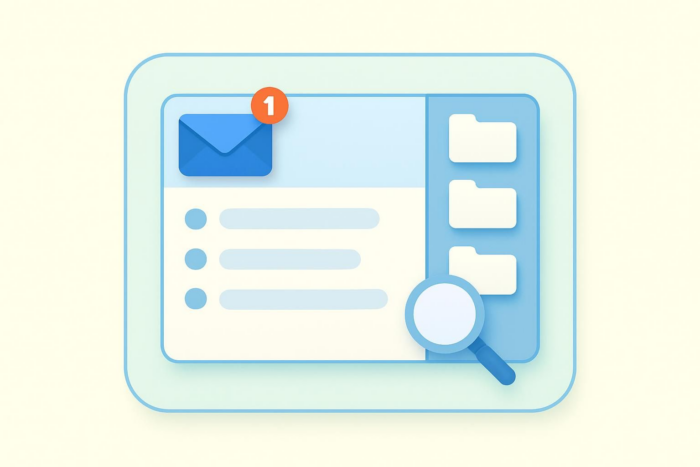
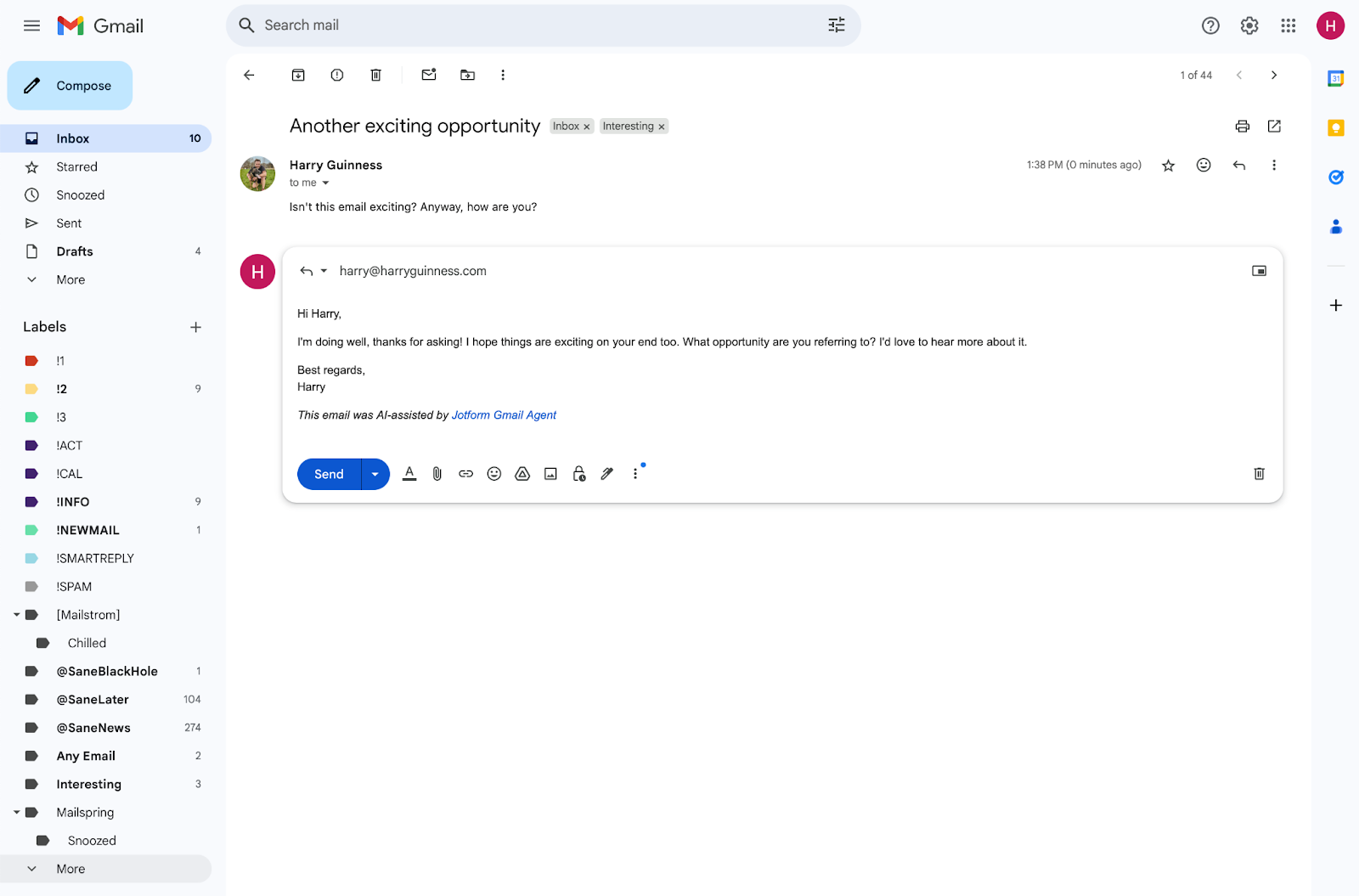

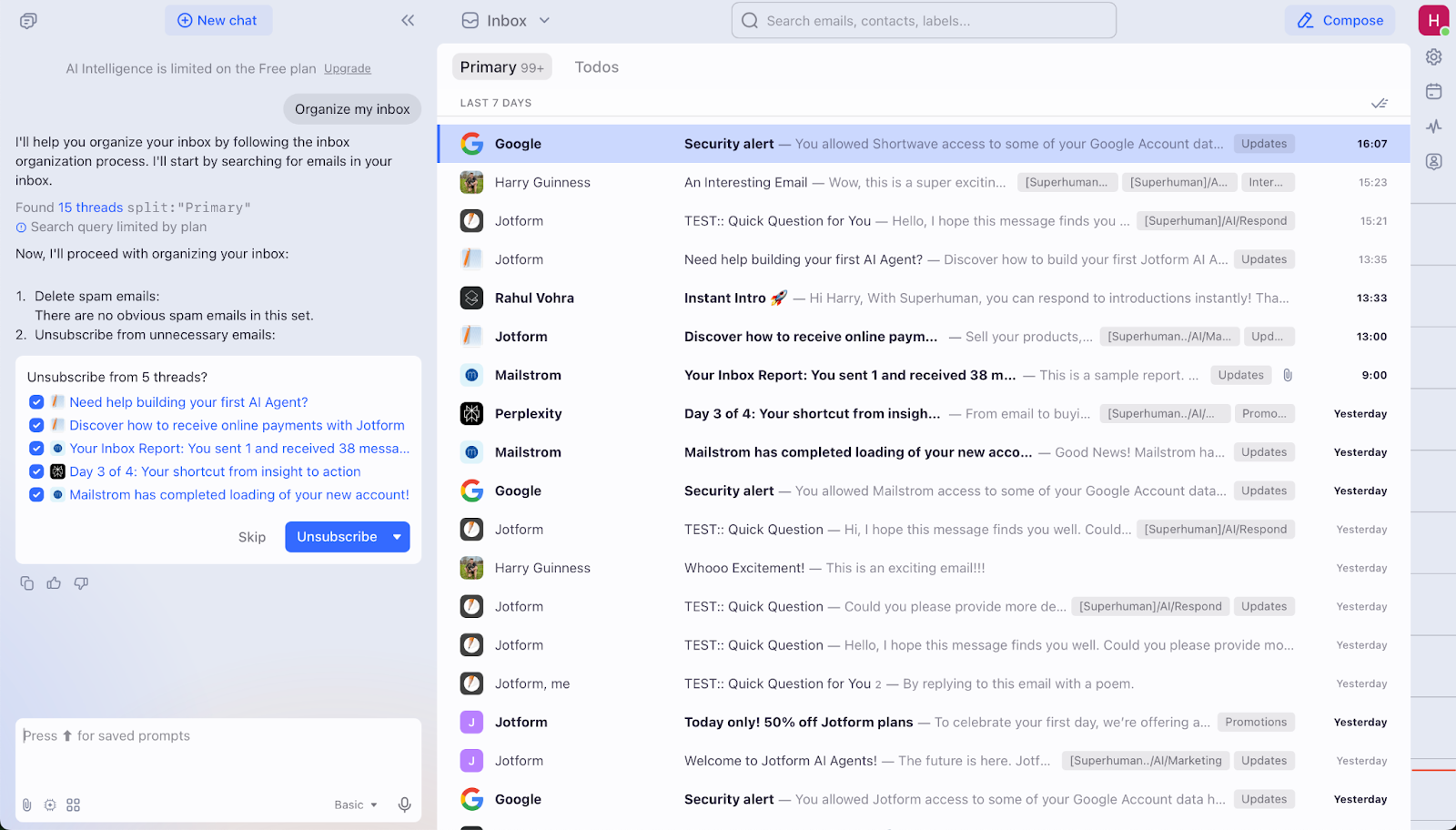

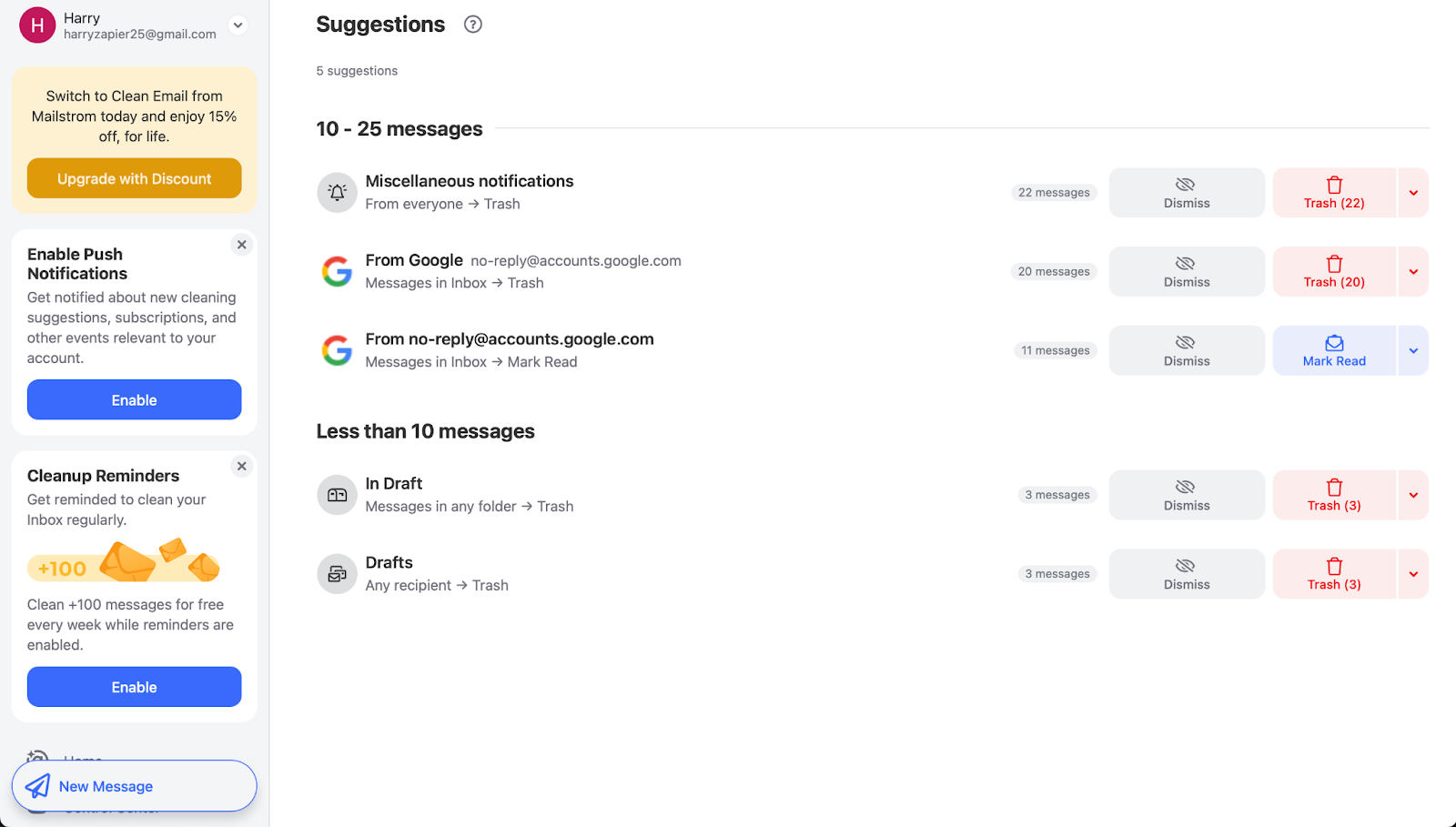
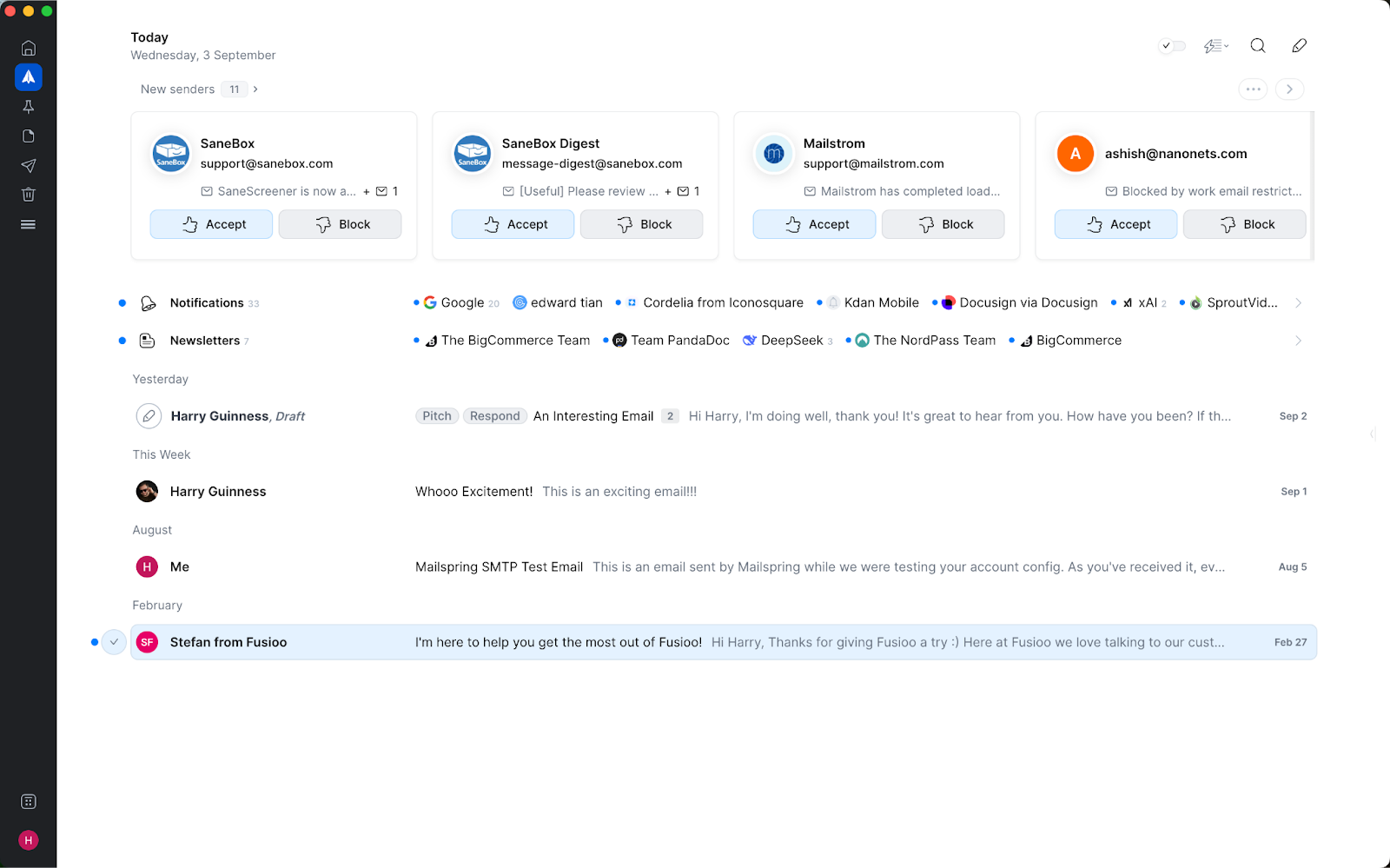

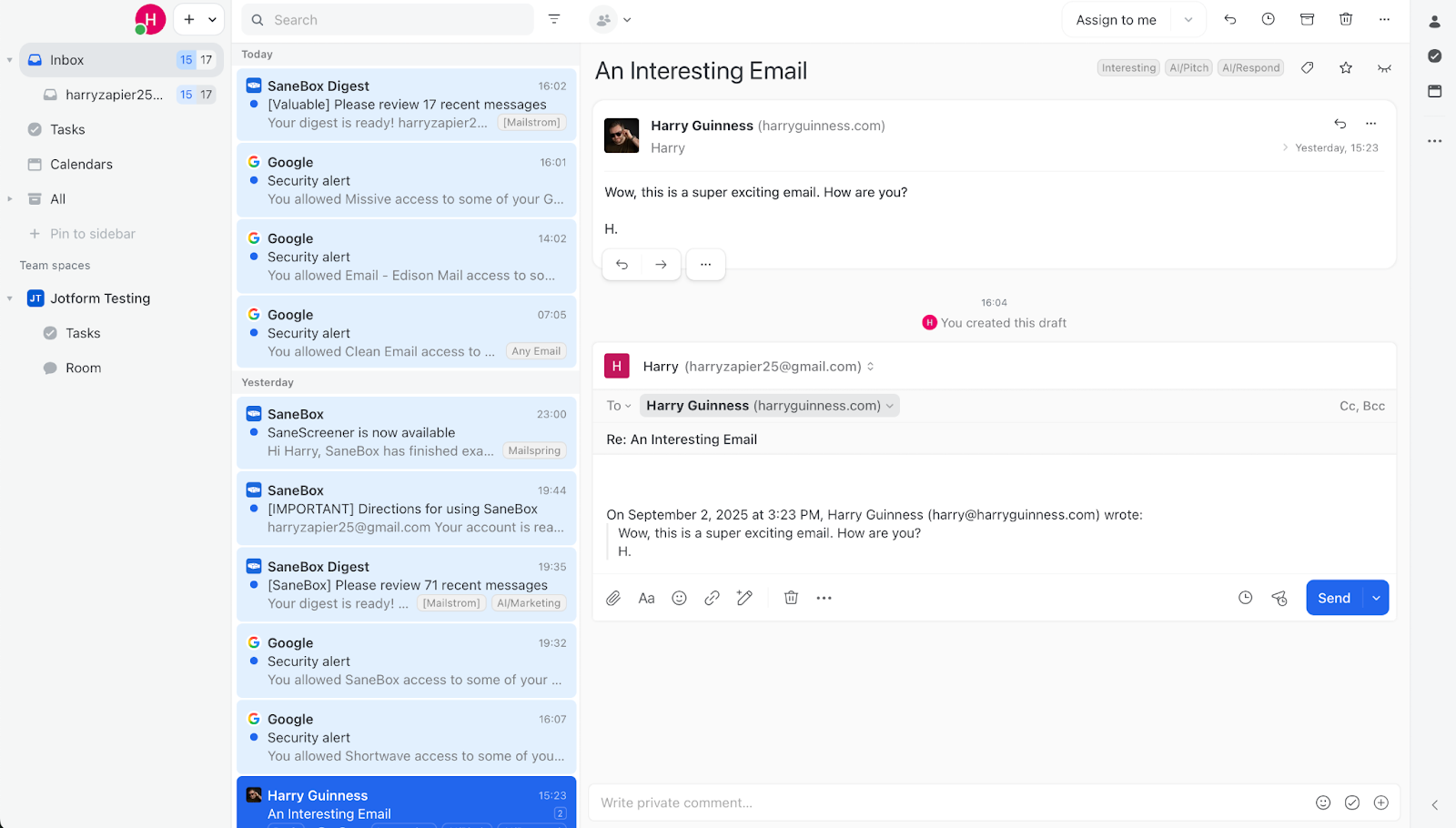

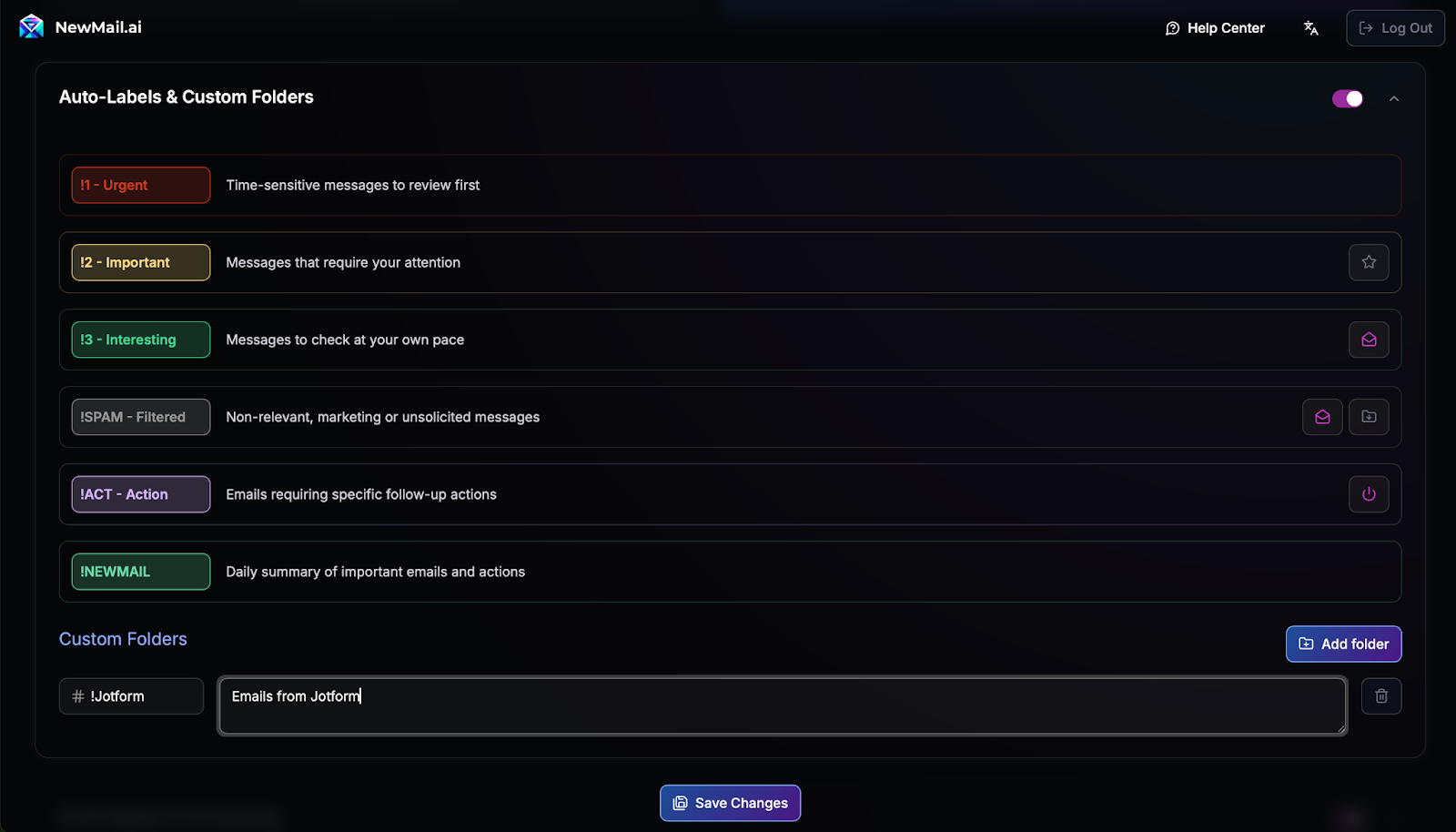
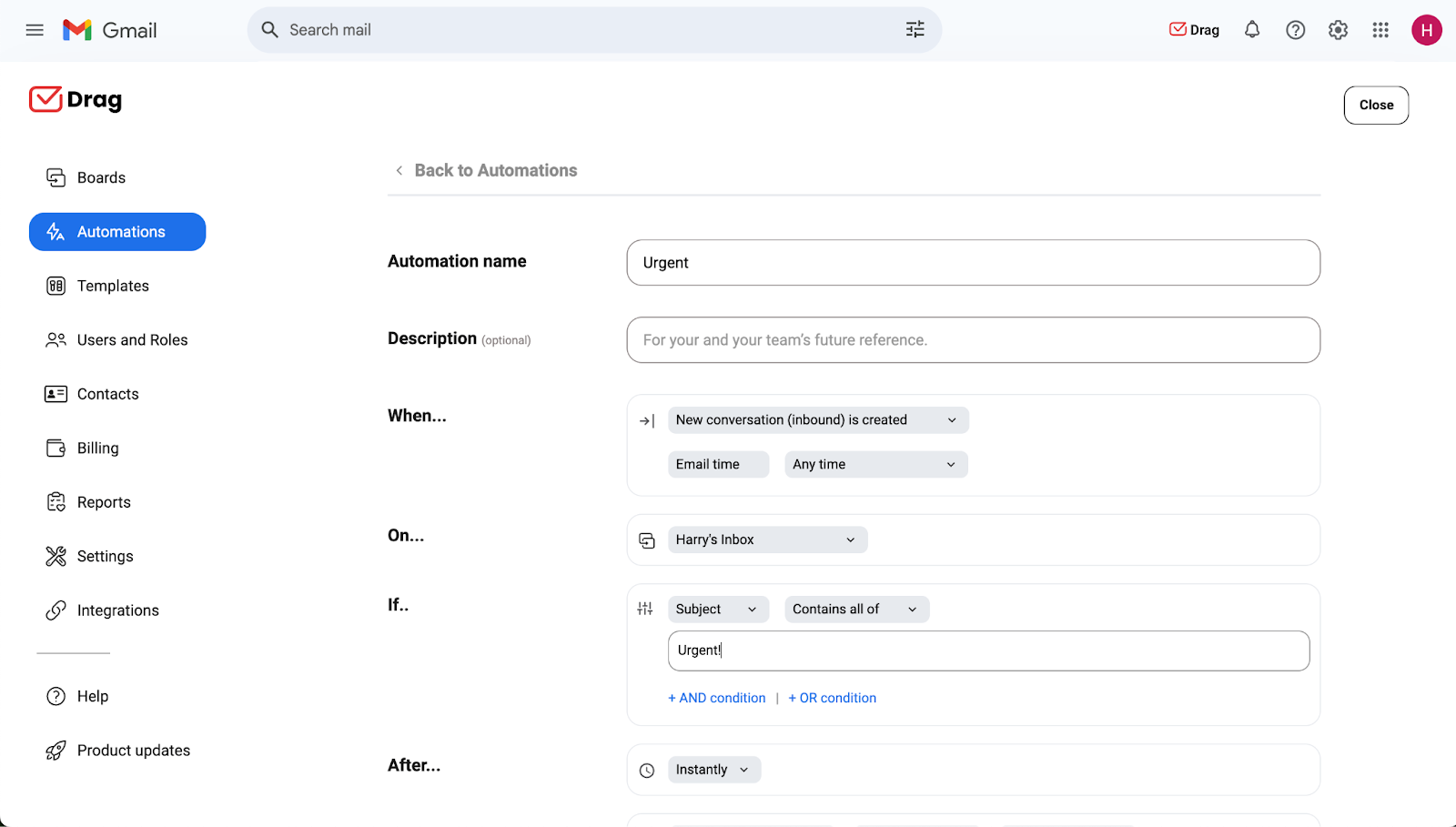









Send Comment: